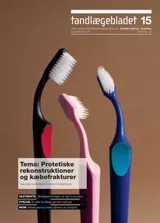Protetiske aspekter inden for traumatologien
Protetisk rehabilitering efter traume kræver overvejelser om, hvordan det bedste æstetiske resultat kan opnås for den enkelte patient ved anvendelse af den mindst invasive teknik, der samtidig giver tilstrækkelig retention og styrke af restaureringen. Provisoriske erstatninger bør anvendes længst muligt, og hvis det bliver nødvendigt at erstatte tandsubstans, kan kronetyper med anvendelse af adhæsiv teknik anbefales for ikke misfarvede tænder, mens misfarvede tænder kræver helkeramiske eller metalkeramiske kroner med ikke translucent inderkappe. Hvis traumet resulterer i tandtab, vil implantatbehandling være valget, hvis nabotænderne er intakte, tandsættet udviser sunde parodontale forhold, og patienten skønnes at kunne opretholde god mundhygiejne. For at opnå et optimalt æstetisk resultat kræves hyppigt vertikal og horisontal knogleopbygning såvel som bindevævsopbygning, inden implantatrekonstruktionen fremstilles.
Prosthetic aspects in traumatology
Prosthetic rehabilitation of traumatized anterior teeth include considerations concerning how the most satisfying esthetic result can be obtained using minimal invasive technique with sufficient retention and strength of the reconstruction. Temporary restorations should be in function as long as possible and minimal invasive preparation techniques for bonded laminates and crowns are preferable for non-discolored teeth. For discolored, non-vital teeth All-ceramic or porcelain fused to metal crown are needed. If teeth have to be replaced after injury, implant-supported crowns should be chosen if the neighboring teeth are intact and healthy periodontal conditions are present. To obtain an optimal esthetic outcome vertical and horizontal hard and soft tissue augmentation are frequently needed adjacent to implant-supported reconstructions.


